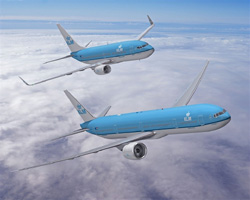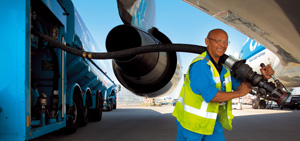Flying high on fuel-efficiency
on
Flying high on fuel-efficiency
Within an industry where little things count in terms of weight, distance and economy, KLM Royal Dutch Airlines has come a long way in maximizing its fuel- efficiency.
 KLM has almost turned fuel-saving into a culture: since 2003 an increasing part of its entire organisation has been involved in decreasing kerosene consumption. This in order to save both costs and climate, as burning up one kilo of jet fuel creates 3.2 kilo CO2.
KLM has almost turned fuel-saving into a culture: since 2003 an increasing part of its entire organisation has been involved in decreasing kerosene consumption. This in order to save both costs and climate, as burning up one kilo of jet fuel creates 3.2 kilo CO2.
There is a lot at stake. The 214-strong fleet of KLM and its subsidiaries used up over 3.5 million tons of jet fuel in 2008. The resulting bill was over €2bn, which accounts for almost one-third of the air carrier’s total operational costs.
In KLM’s broad approach towards fuel-saving, statistics and optimisation of routes and fleet are the key words in a continuing process, focused at increasing the company’s competitiveness. By paying attention to every detail within its flight operations, KLM tries to predict the amount of fuel needed for every flight as accurately as possible.
Keeping weight to a minimum, in order to burn as less fuel as possible, is paramount for the cockpit crews, explains Ype de Haan, KLM’s executive vice-president operations. To avoid carrying any surplus fuel, KLM’s cockpit crews calculate the amount needed only half an hour before the flight, taking into account the company’s decision to reduce the minimum amount of contingency fuel – meant for unforeseen circumstances – from fifteen to five minutes flying time. De Haan stresses that contingency fuel is just one component of all fuel carried. ‘It supplements the legally prescribed amount of fuel for alternate routes and taxiing. If an aircraft has insufficient fuel, it can always divert for refuelling. Worldwide, KLM aircraft carry the lowest volume of fuel on arrival,’ says De Haan. ‘However, safety is always our number one priority.’
The Dutch air carrier goes even further to reduce weight. ‘By applying thinner and smoother paint layers, we have managed to decrease the total paint weight by 15%,’ De Haan points out. ‘On long-haul flights, we now take the papers trolley from board before we depart. And where possible, we have replaced paper information on board by electronic data. Together with new light-weight trolleys on the Boeing 737 and light-weight drawers, crockery and baggage containers on intercontinental flights, we have reduced the dead weight by 480 kilos on long-haul flights.’
KLM relies heavily on statistics in its drive towards fuel-effiency. De Haan: ‘Statistics are decisive in assessing how much fuel is needed for every flight. We take into account the taxiing time as well as the option of switching off engines while taxiing, but we also anticipate the likelihood of being kept in the air when arriving at a busy time. And in case a plane must be diverted, our policy is to head for the nearest suitable airport, instead of holding in the air near the final destination.’
Pinpoint accuracy
KLM’s most recent effort towards maximum fuel-efficiency entails regional flights waiting on the ground, if poor weather at Schiphol is forcing incoming planes to queue-up in the air. De Haan: ‘We need pinpoint accuracy in this, and we need to explain the reason of the delay to the passengers. But we have found that they do appreciate this, because most of them also don’t like wasting fuel while flying around in circles.’
At present, the carrier is researching how adjustments to the descending process can contribute to fuel saving. ‘We are looking for the ideal moment for descend, so we can close the throttle until we need to lower the landing gear. However, we always need to follow the local instructions as well as those from Air Traffic Control,’ De Haan points out.
Statistics have shown that every single plane – even aircraft of the same type and model – burns a different amount of fuel. De Haan: ‘An uneven surface of the fuselage, such as a protruding door rubber, or a slightly underperforming engine, can increase the fuel consumption by one percent. Given the fact that a Boeing 747 burns 45,000 tons of fuel a year on average, the potential for saving is substantial.’ In order to fine-tune the amount of water on board and catering to the actual use on every single route, statistics have also been crucial.
Reduced deployment of the auxiliary power unit (APU), the generator in an aircraft’s tail, is yet another fuel-saving measure applied by KLM. ‘By plugging into the airport’s power grid on arrival, and only switching on the APU just before departure, we can save up to hundreds of kilos of fuel each flight,’ De Haan explains.
 |
| Refueling of a KLM jumbo jet at Schiphol Airport, The Netherlands |
Fuel-efficiency is also a key criterion in the purchasing of aircraft. De Haan: ‘The winglets on our 26 Boeing 737s save up to 3% on fuel, which meant a €4.3 million saving for our fuel bill in 2007. And by replacing our 28 Boeing 747-300s and 747-400s over time by Boeing 777-200ERs and 777-300ERs respectively, we are saving up to 25% of fuel.’
KLM is eying the even more fuel-efficient planes of the near future, such as the Boeing 787 Dreamliner, for which its manufacturer claims a fuel reduction of 20% compared to today’s similar-sized planes. Airbus promises that its wide-bodied A350 will have a 25% better fuel-efficiency than today’s aircraft within its segment, such as the Boeing 777.
Single European Sky
Aother major effort goes into optimizing routes through the sky. On the principle that a direct route is the shortest, the Dutch air carrier is lobbying national regulators as well as civil and military aviation authorities, in order to get all traffic control obstacles removed from the European airspace. ‘A Single European Sky will lead to a fuel-saving of at least ten percent,’ predicts KLM’s chief operations.
Recently, restrictions over the Benelux countries and Northern Germany have been eased, in line with the EU Directive Single European Sky to streamline air traffic management in the entire EU airspace by 2018. ‘Together with France and Switzerland, these countries account for 55% of all air traffic in Europe,’ explains spokesman Fred Keuzeman of Eurocontrol, tasked with guiding air traffic in the now de-restricted airspace. According to Keuzeman, every flight in Europa makes a detour of 50 kilometres on average at the moment.
Farther afield, as Chairman of the operational committee of the International Air Transport Organisation (IATA), De Haan is trying to persuade the Chinese government to open up more direct routes into the country. ‘Because of the limited mastering of English by Chinese traffic controllers as well as military restrictions, entry into China’s air space is now significantly limited,’ he explains.
Recently, the US authorities decided to reduce the minimum allowed distance between planes in its airspace, following lobbying by IATA. De Haan: ‘The result is that more aircraft can benefit from flying at the most fuel-efficient altitude. There is a lot of potential gain, if we could roll out a similar scheme in the airspace of the Russian Federation, India and Africa.’
De Haan says that his company doesn’t mind sharing the results of its fuel-saving efforts with other airlines, including its competitors. ‘It will allow us all to burn less fuel and emit less greenhouse gas as a consequence,’ he argues.
De Haan says he isn’t afraid of competing airlines taking advantage of KLM’s knowledge. ‘They still need to do their own sums on the various applications, and they need to implement a cultural change. It might take ten years before all cockpit crew has been convinced of the practicalities and safety of the measures.’
Asked about the performance of KLM, a spokesman of IATA says the organisation does not rate its members for fuel-efficiency. In 2007, a study by independent environmental research bureau CE Delft, commissioned by the World Wildlife Fund Netherlands, found that KLM was “best in class” in reducing CO2 emissions through fuel-efficiency and technological innovations, compared to other large carriers.
According to the report, KLM’s operations produced 8.2 kilos of CO2 per RTK, the unit for measuring transporting 100 kilos over one kilometre. In comparison, British Airways, Lufthansa and Singapore Airlines produced 10.2, 9.4 and 8.3 kilos CO2 per RTK respectively. Although Cathay Pacific scored only 8 kilos per RTK, CE Delft said it still considered KLM to be the most fuel-efficient airline, as it has proportionally more short and medium haul operations and a fleet adapted to such shorter flights.


Discussion (0 comments)